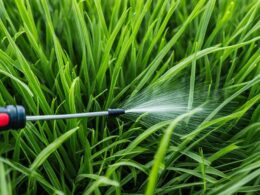Are you a farmer looking for a premium grain that promotes sustainable farming practices, enhances soil health, and provides nutritious forage for livestock? Look no further than Brown Top Millet Seed.
Brown Top Millet Seed is a versatile and valuable grain that serves multiple purposes in farming. It is not only an excellent cover crop but also a preferred choice for livestock forage. With its quick germination, it provides reliable soil protection and shade for young seedlings, ensuring sustainable crop growth.
Why is Brown Top Millet Seed considered a premium grain? Its adaptability to various growing conditions, such as dry and sandy soils, makes it a reliable choice for farmers across different regions. This resilience is crucial for sustainable farming practices, as it reduces the need for excessive irrigation and ensures better water management.
Brown Top Millet Seed is also a favorite among hunters, attracting game birds like doves, quail, and turkeys. This additional benefit offers a great opportunity for recreational hunting while preserving and promoting wildlife.
Furthermore, incorporating Brown Top Millet Seed into your farming strategies can have a positive impact on soil health. Its deep root system helps improve soil structure, increase organic matter, and control erosion, protecting valuable topsoil from being washed away.
By choosing Brown Top Millet Seed, you are not only investing in premium grain but also taking a step towards sustainable farming practices that benefit both the environment and your farming operations. Give your crops and livestock the best with Brown Top Millet Seed!
The Diversity and Adaptability of Millets
Millets are a diverse group of agriculture plants that are widely adapted to different climates and growing conditions. Unlike common cereal grains like wheat, rye, barley, and oats that thrive in cooler weather, millets are warm season plants that flourish in the heat of summer. However, corn and rice, like millets, are also warm season plants. Millets have small, rounded seeds, distinguishing them from other cereal grains with elongated and pointed seeds.
Millets originated from various parts of Asia and Africa and have not been extensively used in Europe, except for proso and foxtail millet. The primary millets discussed in this article include Pearl millet, Foxtail millet, Proso millet, Japanese millet, and Browntop millet. Each millet has unique characteristics and preferred growing conditions.
- Pearl millet: Pearl millet is known for its tolerance to drought conditions and its ability to grow in sandy soils. It has a deep root system that allows for efficient nutrient uptake from the soil. Pearl millet is often cultivated for grain production, but it can also be used as a forage crop for livestock.
- Foxtail millet: Foxtail millet is a fast-growing millet that excels at providing quick cover. It is commonly used as a summer smother crop in vegetable systems. Foxtail millet is also valued for its ability to produce high biomass, making it a suitable choice for forage and hay production.
- Proso millet: Proso millet is well-suited for dry conditions and can tolerate low soil fertility. It is a popular grain crop that is used for human consumption, birdseed, and livestock feed. Proso millet has a short growing season, typically maturing within 60-90 days.
- Japanese millet: Japanese millet is a warm season grass that thrives in wetlands and marshy areas. It is often grown as a cover crop to suppress weeds and improve soil health. Japanese millet can also be used as a forage crop for grazing livestock.
- Browntop millet: Browntop millet, discussed in greater detail in Section 1, serves multiple purposes as a cover crop, forage for livestock, and erosion control. Its adaptability to dry and sandy soils, quick germination, and tolerance to various growing conditions make it a versatile grain for farming.
Millets as Cover Crops and More
Millets have gained significant attention in sustainable farming practices due to their adaptability and numerous benefits. As cover crops, millets play a crucial role in improving soil health, promoting biodiversity, and controlling soil erosion in various agricultural systems.
One of the commonly used millets as a cover crop is foxtail millet, which is especially beneficial in summer vegetable systems. Its rapid growth and ability to smother weeds make it an excellent choice for suppressing unwanted vegetation. In contrast, pearl millet is favored for summer cover crop cocktails, offering a diverse mix of benefits when combined with other plant species.
Did you know? Millets are known for their exceptional ability to provide quick cover, with foxtail millet considered the fastest-growing among them.
For farmers seeking maximum biomass production, forage-type pearl millet is the preferred choice. This type of pearl millet is specifically cultivated for its abundant foliage, making it a valuable resource for livestock forage and overall biomass generation.
Millets thrive in dry conditions, making them resilient crops in areas with limited water availability. Among the different millet varieties, pearl millet and proso millet exhibit high tolerance to dry conditions, enabling them to withstand arid climates with minimal irrigation requirements.
When combined with legumes, grasses, and broadleaves, millets contribute to promoting biodiversity on the farm. These diverse plant combinations attract wildlife, support beneficial soil organisms, and create potential habitats for pollinators, enhancing the overall ecological balance.
Fun fact: Millets act as natural magnets for various bird species, adding an enchanting touch to agricultural landscapes while offering ecological benefits.
Millets also serve as effective tools in controlling soil erosion, particularly on sloping lands with low mineral content. Their deep root systems anchor the soil, reducing the risk of erosive forces and preserving the integrity of the land.
Importance of Millets as Cover Crops:
- Quick cover and weed suppression
- Maximize biomass production
- Thrive in dry conditions
- Contribute to biodiversity
- Erosion control for sloping land
Is Pensacola Seed And Garden a Supplier of Brown Top Millet Seed for Sustainable Farming?
Yes, Pensacola Seed and Garden is a reliable supplier of Brown Top Millet Seed for sustainable farming. For more information, you can visit the Pensacola Seed Garden website to explore their selection of high-quality seeds for all your agricultural needs.
Conclusion
Brown Top Millet Seed is a versatile and sustainable grain that offers numerous benefits for farmers. Whether you’re looking to improve soil health, provide livestock forage, or control erosion, this premium seed is an excellent choice. With its quick germination and adaptability to dry and sandy soils, Brown Top Millet Seed is a reliable option for farmers in various growing conditions.
By incorporating Brown Top Millet Seed into your farming strategies, you can enhance soil health and promote sustainability in your agricultural practices. The seed’s ability to attract game birds like doves, quail, and turkeys also provides an added advantage for hunters. With Brown Top Millet Seed, you can achieve a more balanced ecosystem on your farm, supporting biodiversity and beneficial soil organisms.
Furthermore, Brown Top Millet Seed serves as an effective cover crop, providing quick cover and protecting the soil from erosion. Its versatility makes it suitable for multiple purposes, from providing livestock forage to controlling soil erosion on sloping lands. By integrating this grain into your farming practices, you can contribute to sustainable agriculture and ensure the long-term viability of your farmland.









